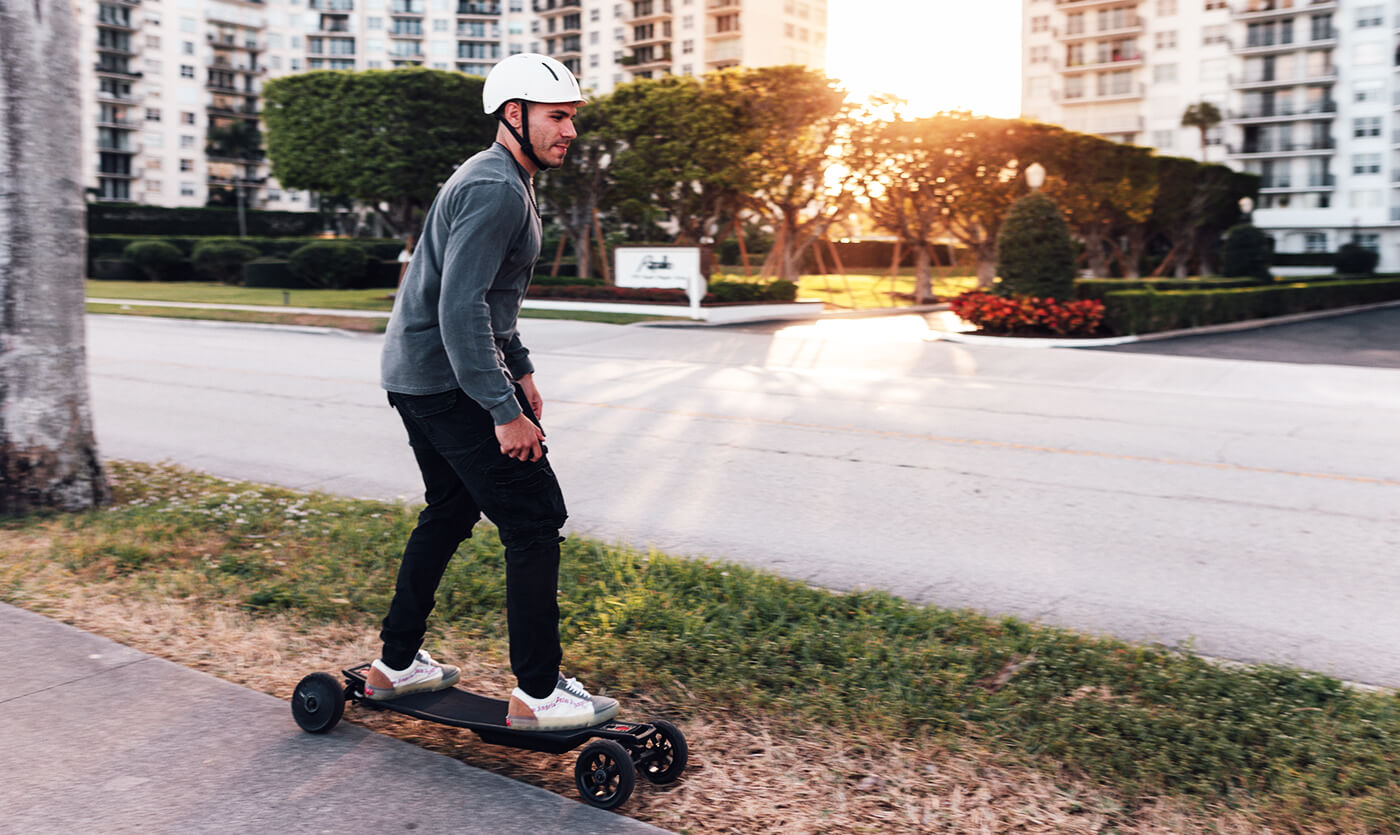Electric skateboards have become a favorite way to get around town—quick, fun, and eco-friendly. But as more riders hit the streets, one question keeps coming up: can you legally and safely ride an electric skateboard on pavements? The short answer is: it depends on where you live. Rules vary from place to place, and even within the same state or country, the laws can change from city to city. In this guide, we’ll break down what you need to know, how to find local rules, what to do if sidewalk riding isn’t allowed, and how to ride safely and respectfully in public spaces.

Why This Matters for Electric Skateboard Riders
Many electric skateboard riders—especially commuters and beginners—prefer pavements because they seem safer than riding in traffic. Cars and buses can be intimidating, especially in busy areas or on narrow roads. Sidewalks offer a sense of safety, smoother paths, and fewer obstacles. But the catch is that pavements are primarily designed for pedestrians. And that’s where things get tricky.
If you’re riding on a pavement, you might be sharing space with walkers, children, dogs, or people with strollers. If your skateboard goes fast or makes sharp turns, it can pose a risk—not just to others, but to you too. So even if riding on the sidewalk feels convenient, it’s important to know whether it’s allowed and how to do it responsibly.

Are Electric Skateboards Allowed on Pavements?
There’s no universal law about electric skateboards on pavements. What’s allowed in one city could get you fined in another. The rules depend on how your local government classifies electric skateboards. In many places, they’re considered motorized vehicles or “personal mobility devices,” similar to e-scooters. Once a board is motorized and exceeds a certain speed or power, it’s often restricted from pedestrian zones like sidewalks or pavements.
For example, in California, electric skateboards are legal under certain conditions, but they generally can’t be ridden on sidewalks. In some cities in Europe, only boards that meet specific speed and power limits are allowed on shared paths. Other cities ban them completely from pavements and require riders to use bike lanes or roads.
In the U.S., laws vary not just by state but also by county or city. That’s why it’s essential to check your local ordinances before you ride. A rule that allows e-scooters might not apply to electric skateboards—and vice versa.

How to Know If You Can Ride on Pavements
Before you jump to the rulebook, take a quick look at your real-world setting. Pavement rules for electric skateboards are often enforced in context, and the context you’re in can change the answer—even within the same city.
-
Location type matters.
Busy downtown shopping streets and business districts are the likeliest places to restrict riding. Quiet residential blocks or shared-use greenways are more permissive, especially at off-peak times. -
Pedestrian density matters.
If the walkway is crowded (schools letting out, weekend markets, tourist areas), plan to walk the board. Low-foot-traffic stretches are where slow, courteous riding is most acceptable where legal. -
Posted signs and surface markings matter.
Look for “No Riding,” “Pedestrians Only,” or speed-limited shared-path signs. Tactile paving at crossings and narrow, obstacle-filled sidewalks are practical red flags even if rules are silent. -
Time of day matters.
Some corridors are fine early morning but unsuitable at lunch or rush hour. Adjust your plan by time, not just place. -
Your setup matters.
Boards without lights/reflectors, loud braking, or high-speed modes invite complaints and stops. A low-speed mode and visible gear make legal use easier where allowed.
Once you’ve sized up the scene, confirm the letter of the law with this quick method:
-
Search your city’s government site.
Use terms like “electric skateboard,” “personal mobility device,” or “sidewalk use.” Check transportation, public works, or police pages. -
Check state or provincial rules next.
State law may define devices and set broad limits; local ordinances usually govern day-to-day enforcement. -
Scan for on-street cues.
Obvious signage beats guesswork. Shared-path icons, “No E-devices,” or speed caps tell you what to do right now. -
Call or email a non-emergency contact.
A quick note to the transportation department or community policing unit often gets you a clear, quotable answer. -
Cross-check with local rider communities.
Neighborhood Facebook groups, Reddit threads, or campus updates reveal how rules are applied on the ground (detours, ticket hotspots, best routes).

What to Do If Pavement Riding Isn’t Permitted
If you find out that riding on pavements isn’t allowed in your city, don’t worry—there are still plenty of ways to get around on your electric skateboard legally and safely.
-
Use bike lanes: Many cities allow electric skateboards in bike lanes, which are usually safer than car traffic and offer more space than sidewalks.
-
Ride on quiet streets: Residential areas or roads with low speed limits are often more comfortable for e-board riders. Look for roads with “sharrows” or signage indicating shared use.
-
Map your route ahead of time: Apps like Google Maps or specialized micromobility apps can help you avoid areas where sidewalks are restricted.
-
Carry or push your board: In no-ride zones, simply dismount and walk your board. Most electric skateboards are light enough to carry short distances.
-
Use mixed-mode travel: Combine your e-board with public transit or walking to cover longer distances without breaking any rules.
Following local laws not only helps you avoid fines but also builds a better reputation for the electric skateboard community as a whole.
Tips for Riding Safely and Respectfully
Even in areas where riding on pavements is allowed, it’s important to share the space responsibly. Here are practical tips to keep you—and everyone around you—safe:
-
Always yield to pedestrians: People on foot have the right of way on pavements. Slow down or stop completely when passing.
-
Ride at a walking pace: Keep your speed low, especially in crowded areas. Fast riding on sidewalks is not only dangerous but often illegal.
-
Stay visible: Use lights and reflective gear, especially if riding at dawn, dusk, or night. It helps both pedestrians and drivers see you.
-
Avoid sudden movements: Sharp turns or sudden stops can surprise others and cause accidents. Ride smoothly and predictably.
-
Watch for surface hazards: Pavements can be uneven, cracked, or slippery. Slow down near curbs, bumps, or wet areas.
-
Wear protective gear: At minimum, wear a helmet. Gloves, knee pads, and elbow pads add extra protection, especially for newer riders.
Being courteous and cautious not only protects you but also helps ensure that cities continue to allow electric skateboards in shared spaces.
Quick FAQ for Electric Skateboards
Q: Can I ride my electric skateboard on the pavement in my city?
A: It depends. Local rules vary. Check your city’s government website or contact your local transport office to get a clear answer.
Q: Do I need a helmet or lights to ride on pavements?
A: Many places require helmets and lights, especially at night. Even if it’s not the law, they’re smart safety choices.
Q: What’s a safe speed on pavements?
A: Think jogging pace—about 5–7 mph. If you can’t stop safely within a few feet, you’re going too fast for a sidewalk.
Q: Can I get fined for riding on pavements?
A: Yes. In areas where it’s prohibited, fines or warnings are possible. Know the rules and ride respectfully to avoid trouble.
Q: What should I do if I’m stopped by law enforcement?
A: Stay calm, dismount, and respectfully ask for clarification. Most officers will explain the rule and let you walk away without issue.
Conclusion
Electric skateboards offer a fun and efficient way to travel, but where you ride matters. Pavements can feel like a safe option—but only if local laws allow it. Always check your city’s regulations, plan your route accordingly, and ride with care and courtesy. Whether you're gliding down a quiet street or sharing space with pedestrians, knowing the rules will help you avoid problems and enjoy the ride.
More Reading: What to Wear for Electric Skateboarding





Share:
How do You Steer an Electric Skateboard?
What Is a 2-in-1 Electric Skateboard?